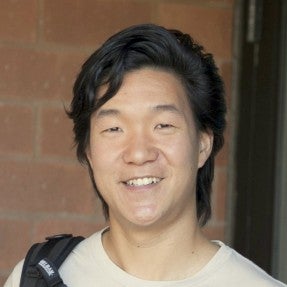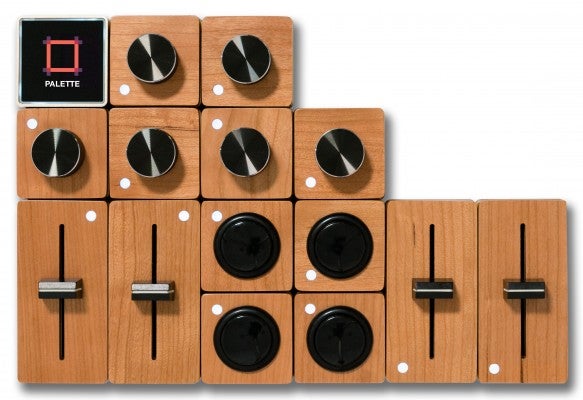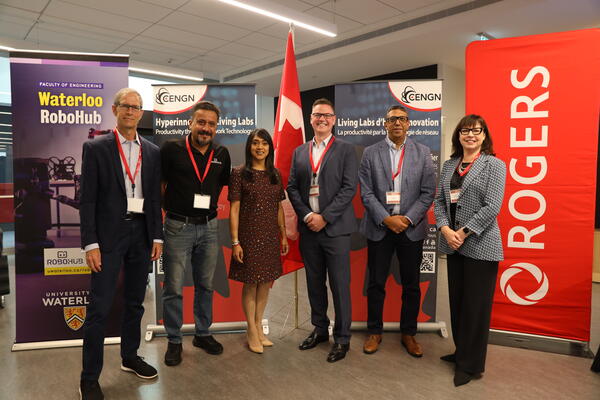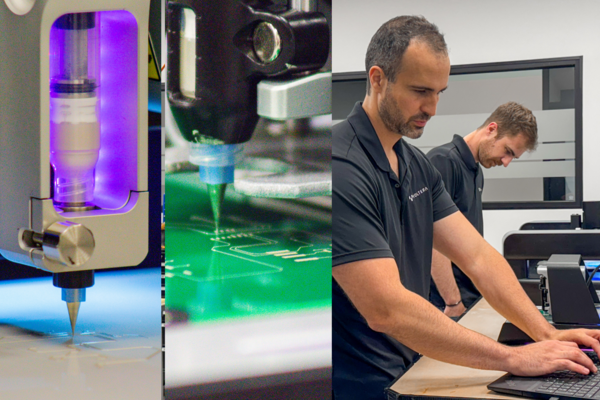
Palette puts you in charge of interface design
Combining technology in ways that make Lego pieces look complex in comparison

Combining technology in ways that make Lego pieces look complex in comparison
By Shane Schick Faculty of EngineeringThe term ‘plug and play’ — which suggests various pieces of computer hardware can be snapped together with ease — had a dubious history in the technology industry. What’s often described as plug and play turns out to be more difficult to use than expected. If Calvin Chu is successful, however, people will soon be combining technology in ways that make Lego pieces look complex in comparison.
 Palette, founded in fall of 2013, is Chu’s exciting new startup. Founded while he was an undergraduate in the University of Waterloo’s Mechatronics Engineering program, Palette allows you to personalize your controllers, by making a kit of modules that connect via USB to a software program. The modules are a mix of buttons, dials and “sliders” that look like controls used in sound recording studios. Instead of having to sit down and learn how to operate a piece of hardware, Palette lets people configure these controls the way they want.
Palette, founded in fall of 2013, is Chu’s exciting new startup. Founded while he was an undergraduate in the University of Waterloo’s Mechatronics Engineering program, Palette allows you to personalize your controllers, by making a kit of modules that connect via USB to a software program. The modules are a mix of buttons, dials and “sliders” that look like controls used in sound recording studios. Instead of having to sit down and learn how to operate a piece of hardware, Palette lets people configure these controls the way they want.
“A big problem we see is that we spend so much time on our computers and devices and are very connected to the digital world, but there’s a big gap into the interface to do that,” Chu says. “We’ve all been using a one-sized-fits-all generic keyboard and mouse. The designs for those came from what we’d had on typewriters, which are even older in terms of a design. We want to help people create the best tools for their work.”
Palette is initially being aimed at creative professionals, Chu says. This could include photographers that would use its gear to more easily edit images, or filmmakers and musicians who want to customize their production processes. Over time, though, Chu believes Palette could be applied in a wide range of industrial, manufacturing or other sectors.
“I’d always been interested in computer interaction. My electives were in that,” Chu says, recalling that Waterloo engineering’s unique education not only provided him with great professors but opportunities for hands-on learning and engineering research.
“Co-op was definitely one of the highlights for me,” he says, citing stints in New Zealand and Sweden with Trimble Navigation, where he helped test next-generation cameras and satellite receivers, among other things. “Those were pretty memorable work experiences.”
Although still a young company, Palette has already conducted a very successful product launch for a photo editing kit and has raised $158k from 925 backers on popular crowdfunding platform Kickstarter. It was an experience that he says offered a lot more than money, though.
“We really got to connect with the community,” he said. “It became a close dialogue where people were offering suggestions or feedback that wouldn’t have been possible otherwise.”

As Palette grows, Chu recommended Waterloo Engineering students, who are looking to engineer the future, spend time thinking not only about breakthrough technology or business ideas, but with whom they want to pursue their dreams. Being part of a great university is a huge opportunity to start forming those relationships, he adds, and to become an engineering startup — 500+ Startups.
“It’s all about the team and the people around you,” he says. And much like Palette’s modules, success may be largely about how you put those people together.

Read more
Living Lab initiative will help Canadian companies test and validate products and services at Waterloo’s RoboHub

Read more
Voltera prints electronics making prototyping faster and more affordable — accelerating research to market-ready solutions

Read more
New funding accelerates the deployment of Cobionix’s medical robotics platform across North America and the UK
Read
Engineering stories
Visit
Waterloo Engineering home
Contact
Waterloo Engineering
The University of Waterloo acknowledges that much of our work takes place on the traditional territory of the Neutral, Anishinaabeg, and Haudenosaunee peoples. Our main campus is situated on the Haldimand Tract, the land granted to the Six Nations that includes six miles on each side of the Grand River. Our active work toward reconciliation takes place across our campuses through research, learning, teaching, and community building, and is co-ordinated within the Office of Indigenous Relations.